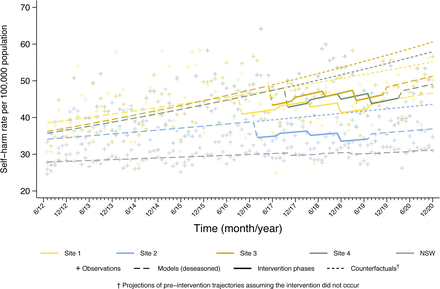Discussion
Implementation of LifeSpan was associated with a significant relative reduction in hospital-presenting ISH of 13.8% across all sites, and no statistically significant reductions were observed for suicide rates. The overall effect for ISH was most pronounced in the late stage of the intervention (18.5%) and appeared to be maintained for up to 8 months following the intervention period. No significant rate reductions in hospital-presenting ISH were observed for the rest of NSW during the study period. These findings suggest that LifeSpan could contribute to large decreases in the absolute numbers of self-harm cases in the general population.
Although we found positive changes in ISH rates overall, effects varied by site. Significant rate reductions were only observed in the overall implementation of site 3 and during the final implementation phase for site 4. While rate reductions in all sites were in the right direction, non-significant findings may be related to smaller IRRs and lower precision of the estimates, particularly in Site 1, and to the absence of important rate predictors (ie, sex, age) in the prespecified models.
In four communities in NSW where rates of suicide and/or ISH were higher than the state average, the LifeSpan multi-strategy intervention was observed to reduce rates of ISH at the population level. This finding may be attributable in part to our efforts to address methodological limitations of previous trials of multi-strategy suicide prevention interventions. It is the first study to use a pragmatic SW design to trial an intervention of this magnitude, providing ethical advantages over other trial designs,22 as all sites had equal opportunity to benefit from the LifeSpan intervention. Because it is one of the largest and most robust efforts to test the real-world impacts of whether prioritisation of evidence-based interventions reduces ISH rates at the population level, it has strong potential to inform policy and resourcing decisions to support actions that will improve suicide prevention efforts in the community. Rather than targeting ‘depression’ as per most previous multi-strategy models, for example,4 5 our model targeted behaviours and processes specific to suicide, based on evidence that such an approach has a greater likelihood of immediate effectiveness.23 The interventions were selected on the basis of demonstrating efficacy for outcomes relevant to this trial, to overcome issues in previous trials where there was over-prioritisation of strategies with limited-to-no intervention effects for suicide or self-harm, which likely contributed to the null effects.8 9 However, even in this trial, there was variation in the underlying effectiveness of the included strategies,10 which is the result of being constrained in the choices of programmes that have undergone rigorous testing.24 As more rigorously tested interventions become available in the suicide prevention field, the model should be revised to integrate current best practices, maximising its effectiveness potential.
Effect heterogeneity was observed between sites, similar to a prior Japanese trial.6 Significant reductions in self-harm rates were observed only in the final two sites to implement the model, and generally only in the late stage of implementation. The order of allocation may have contributed to this variation via the ‘learning effect’ mechanism. That is, late-starting sites likely benefitted from longer planning, access to all the intervention immediately post-transition and implementation learnings generated by earlier starting sites, enabling them to establish the lifespan model more quickly than sites 1 and 2. An insights paper on implementation characteristics and ingredients of success will be reported separately. Between-site differences are also likely to be partly attributable to differences in preimplementation ISH rates. Specifically, baseline ISH rates in site 2 were lower than all other sites, reducing the opportunity to effect significant change.
The post hoc inclusion of ‘sex’ as a constant term in our ISH models reduced error variance and resulted in changes in the effectiveness of the LifeSpan model. Although ISH rates significantly reduced for both sexes over the overall intervention period, effects were greater in females than males (15.9% vs 10.2%). For females, significant reductions in ISH were observed across all stages of the trial, whereas effects for males emerged in the late stage of intervention and then again in the second stage of postintervention follow-up. Because females have rates of ISH two to four times greater than males across the life course,1 the impacts of the LifeSpan model are important for this group. The sex variation in the effectiveness of LifeSpan may be partially explained by differences in patterns of service utilisation; females in suicidal distress are more likely to seek help than males,25 and therefore more likely to be exposed to interventions as well as being captured in administrative data.
Limitations
Site 1 was delayed in crossing over, disrupting the intended structure of the trial by reducing the already low number of steps. This deviation from the original design may have reduced study power and affected our ability to disentangle intervention effects from time-related factors (eg, seasonality, policy changes). The SW design carries a risk of contamination relative to other randomised trial designs, and the later-starting sites may have had access to LifeSpan resources during the repeat baseline measure phase due to their involvement in preparing implementation guides. During the control period, all sites had some suicide prevention programmes in place to differing degrees, making it difficult to determine the causal effect of the intervention and leading to conservative effect estimates. Our expression of interest process may have introduced selection bias, whereby the chosen sites did not accurately represent health agencies across the state in terms of investment in suicide prevention. Baseline rates of self-harm varied between sites, and the sample size calculation was not adjusted to account for differences once sites were selected. As such, our study may be underpowered, resulting in failure to detect a reduction in ISH in the sites with the lowest rates. Moreover, the sample size was powered to ISH only and not change in suicide rates, which is an even rarer phenomenon. This limitation should be considered when interpreting the results, as our null effect for our suicide death endpoint may be an artefact of a lack of power rather than a true absence of effect. Future trials should power their sample size to detect change in rare endpoints to validate and expand on these findings. The intervention period of 2 years is short for a trial of this scale. It is likely to take time to see the full effects of the multi-strategy model, particularly for those interventions that have an upstream, protective function (eg, universal school-based interventions) relative to acute interventions for at-risk individuals. Our self-harm models did not account for repeated admissions, potentially violating the independence assumption and biasing our outcomes towards significance, even though the magnitude of the effects is likely to remain unbiased. Finally, the postintervention follow-up period varied between sites due to the SW design, and the final site only had 1 month of follow-up data in the post-two period. Therefore, the effects of the LifeSpan intervention on longer-term outcomes are not fully known.


